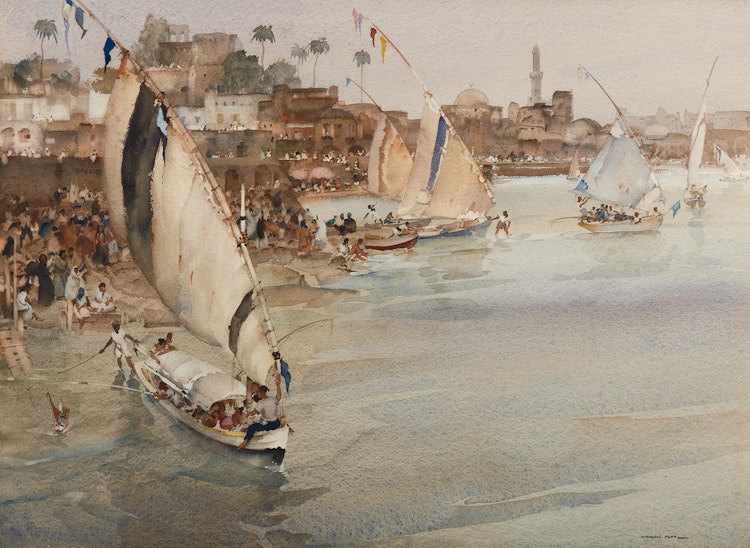Holiday After Ramadan, Cairo by Sir William Russell Flint

Sir William Russell Flint
Holiday After Ramadan, Cairo
watercolour
signed lower right; signed, titled and dated “March-April 1961” on the original card affixed to the backing on the reverse
19.5 x 26.5 ins ( 49.5 x 67.3 cms ) ( sight )
Auction Estimate: $20,000.00 - $30,000.00
Price Realized $19,200.00
Sale date: December 6th 2023
Provenance:
Frost and Reed Limited, London
Lyon & Turnbull, British & European Paintings, London, 30 April 2014, lot 46
Private Estate, Toronto
Frost and Reed Limited, London
Lyon & Turnbull, British & European Paintings, London, 30 April 2014, lot 46
Private Estate, Toronto
Exhibited:
“Exhibition of Works by William Russell Flint”, Royal Academy, London, 1962, no. 136
“Exhibition of Works by William Russell Flint”, Royal Academy, London, 1962, no. 136
Literature:
Ralph Lewis and Keith S. Gardner, “Sir William Russell Flint, R.A., P.P.R.W.S. 1880-1969”, London, 1988, reproduced page 90
Ralph Lewis and Keith S. Gardner, “Sir William Russell Flint, R.A., P.P.R.W.S. 1880-1969”, London, 1988, reproduced page 90
During the 1920s, Flint’s watercolours became increasingly more popular, not only because of their affordability but also their quality. His election as president of the Royal Society of Painters in Watercolours in 1936 only furthered his reputation as one of the foremost British watercolourists of the twentieth century. His works are characterized by a mastery of draughtsmanship, a distinctive sense of perspective and graceful idealism. According to Ralph Lewis and Keith S. Gardner, “[the] beauty of water-colour as a medium is in its transparency. The freshness and freedom it gives a painter can best be appreciated when it is spread in thin washes combined with blobs of luminous colour. An understanding of the nature of the paper to which it is applied is necessary and the rich accents which Russell Flint used—his shorthand of dots, strokes and dashes—are distributed across his paintings like guide lines to lead the eye through his designs.”
As a young man, Flint travelled extensively across the Continent, drawing inspiration from Rome’s sophistication despite preferring the pastoral charm of the Tuscan and Spanish countryside. “Holiday After Ramadan, Cairo” presents bustling crowds of people lining the beach shore against the backdrop of the Egyptian cityscape. The diagonal axis of the sails, with their brightly coloured nautical flags, bisects the composition and ultimately draws the eye of the viewer downward to contemplate the vast expanse of the Nile River. In March 1961 Flint toured the Mediterranean by air with the artist and writer Adrian Bury. His notebook records “R. End of Ramadan, Nile”, published in 1965 by Frost and Reed under the title Holiday After Ramadan. He describes: “Away from the centre of the city the native swarms were totally different and well worth watching. They were picturesque in the full meaning of the word—and after their fast they were out to enjoy themselves, and enjoy themselves they did, ashore and afloat. Many took to the Nile and acted as unsecured ballast for the numerous top-heavy sailing craft. My sketch book had never been kept busier.”
As a young man, Flint travelled extensively across the Continent, drawing inspiration from Rome’s sophistication despite preferring the pastoral charm of the Tuscan and Spanish countryside. “Holiday After Ramadan, Cairo” presents bustling crowds of people lining the beach shore against the backdrop of the Egyptian cityscape. The diagonal axis of the sails, with their brightly coloured nautical flags, bisects the composition and ultimately draws the eye of the viewer downward to contemplate the vast expanse of the Nile River. In March 1961 Flint toured the Mediterranean by air with the artist and writer Adrian Bury. His notebook records “R. End of Ramadan, Nile”, published in 1965 by Frost and Reed under the title Holiday After Ramadan. He describes: “Away from the centre of the city the native swarms were totally different and well worth watching. They were picturesque in the full meaning of the word—and after their fast they were out to enjoy themselves, and enjoy themselves they did, ashore and afloat. Many took to the Nile and acted as unsecured ballast for the numerous top-heavy sailing craft. My sketch book had never been kept busier.”
Share this item with your friends

